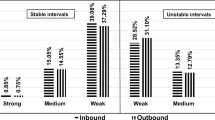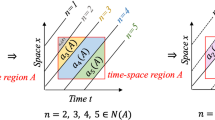Abstract
Travel time is a variable that varies over both time and space. Hence, an ideal formulation should be able to capture its evolution over time and space. A mathematical representation capturing such variations was formulated from first principles, using the concept of conservation of vehicles. The availability of position and speed data obtained from GPS enabled buses provide motivation to rewrite the conservation equation in terms of speed alone. As the number of vehicles is discrete, the speed-based equation was discretized using Godunov scheme and used in the prediction scheme that was based on the Kalman filter. With a limited fleet size having an average headway of 30 min, availability of travel time data at small interval that satisfy the requirement of stability of numerical solution possess a big challenge. To address this issue, a continuous speed fill matrix spatially and temporally was developed with the help of historic data and used in this study. The performance of the proposed Advanced Time-Space Discterization (AdTSD) method was evaluated with real field data and compared with existing approaches. Results show that AdTSD approach was able to perform better than historical average approach with an advantage up to 11% and 5% compared to Base Time Space Discretization (BTSD) approach. Also, from the results it was observed that the maximum deviation in prediction was in the range of 2–3 min when it is predicted 10 km ahead and the error is close to zero when it is predicted a section ahead i.e. when the bus is close to a bus stop, indicating that the prediction accuracy achieved is suitable for real field implementation.










Similar content being viewed by others
Explore related subjects
Discover the latest articles, news and stories from top researchers in related subjects.References
Behera R, Kumar BA, Vanajakshi L Real Time Identification of Inputs for a BATP System Using Data Analytics. International Journal of Civil Engineering, DOI https://doi.org/10.1007/s40999-017-0210-y (2017)
Vanajakshi, L., Subramanian, S.C., Sivanandan, R.: Travel time prediction under heterogeneous traffic conditions using global positioning system data from buses. IET Intelligent Transportation Systems. 3(1), 1–9 (2009)
Jill H, Bahe C, Lou M, and Swenson J. Intelligent transportation systems: helping public transport welfare to work initiatives. Upper Great Plains Transportation Institute, North Dakota State University (2002)
Bhandari, R.R.: Bus arrival time prediction using stochastic time series and markov chains. Ph.D. thesis, Dept. In: Civil Eng. New Jersey Institute of Technology, Newark (2005)
Jeong R, Rilett L The prediction of bus arrival time using AVL data. 83rd Annual Meeting of the Transportation Research Board, National Research Council, Washington D.C., USA (2004)
Patnaik, J., Chein, S., Bladihas, A.: Estimation of bus arrival times using APC data. Journal of Public Transportation. 7(1), 1–20 (2004)
Zhou, Y., Yao, L., Chen, Y., Gong, Y., Lai, J.: Bus arrival time calculation model based on smart card data. Transportation Research Part C: Emerging Technologies. 74, 81–96 (2017)
Padmanaban, R.P.S., Vanajakshi, L., Subramanian, S.C.: Estimation of bus travel time incorporating dwell time for APTS applications. Intelligent Vehicles Symposium. 1931–0587, 955–959 (2009)
Kumar SV, Vanajakshi L Pattern-identification based bus arrival time prediction Institute of Civil Engineers - Transport, Paper: 120001 (2013)
Kumar BA, Vanajakshi L, Subramanian SC Pattern-based bus travel time prediction under heterogeneous traffic conditions. Transportation Research Board, 93rd Annual Meeting (CD-ROM), National Research Council, Washington D.C., USA (2014)
Kumar, B.A., Vanajakshi, L., Subramanian, S.C.: Bus travel time prediction using a time-space discretization approach. Transportation Research Part C: Emerging Technologies. 79, 308–332 (2017)
Kumar, S.V., Vanajakshi, L., Subramanian, S.C.: Location-based data for estimated traffic on urban arterial in heterogeneous traffic conditions. Transportation Research Record: Journal of the Transportation Research Board. 2239, 16–22 (2011)
Sau, J., Faouzi, N.E., Aissa, B.A., Mouzon, O.D.: Particle filter-based real-time estimation and prediction of traffic conditions. Proceedings of the ASMDA, Chania, Crete, Greece (2007)
Vanajakshi, L., Rilett, L.: Support vector machine technique for the short-term prediction of travel time. Proceedings of the IEEE Intelligent Vehicles Symposium. 1931–0587, 600–605 (2007)
Thankappan, T., Vanajakshi, L., Subramanian, S.C.: A Multi-Class Non-Continuum Traffic Flow Model for Congestion Analysis. International Journal of Engineering Studies. 4(3), 207–229 (2012)
Leduc G Road Traffic Data: Collection Methods and Applications. Technical Report, Institute for Prospective Technological Studies, JRC European Commission (2008)
Mori, U., Mendiburu, A., Alvarez, M., Lozano, J.: A review of travel time estimation and forecasting for advanced traveler information systems. Transportmetrica A: Transport Science. 11(2), 119–157 (2015)
Schmitt EJ, Hossein J (2007) On the Limitations of Linear Models in Predicting Travel Times. Proceedings of the 2007 IEEE intelligent transportation systems conference, Seattle, WA, September 30–October 3, 830–835.
Wu C, Su DC, Chang J, Wei CC, Ho JM, Lin KJ, Lee D An advanced traveler information system with emerging network technologies. Proceedings of 6th Asia-Pacific Conference Intelligent Transportation Systems Forum, 230–231 (2003)
Hoffman G, Janko J Travel times as a basic part of the LISB guidance strategy. 3rd International Conference on Road Traffic Control, 6–10 (1990)
Ramakrishna Y, Ramakrishna P, Sivanandan R Bus travel time prediction using GPS data. Proceedings Map India (2006)
Tirachini, A.: Estimation of travel time and the benefits of upgrading the fare payment technology in urban bus services. Transportation Research Part C: Emerging Technologies. 30, 239–256 (2017)
Yu, Z., Wood, J.S., Gayah, V.V.: Using survival models to estimate bus travel times and associated uncertainties. Transportation Research Part C: Emerging Technologies. 74, 366–382 (2017)
Fei, X., Lu, C.C., Liu, K.: A Bayesian dynamic linear model approach for real-time short-term freeway travel time prediction. Transportation Research Part C, Emerging Technologies. 19(6), 1306–1318 (2011)
van Heinsbergen, C.P.I.J., van Lint, J.W.C., Sanders, F.M.: Short Term Traffic Prediction Models. Proceedings of the 14th World Congress on intelligent transport systems, pp. 1–18. ITS, Beijing (2007)
Zheng, P., McDonald, M.: Estimation of Travel Time using Fuzzy Clustering Method. IET Journal on Intelligent Transportation Systems. 3(1), 77–86 (2009)
Yu, B., Wang, H., Shan, W., Yao, B.: Prediction of Bus Travel Time Using Random Forests Based on Near Neighbors. Computer-Aided Civil and Infrastructure Engineering. 33(4), 333–350 (2018)
Bahuleyan H, Vanajakshi L Arterial Path-Level Travel-Time Estimation Using Machine-Learning Techniques. Journal of Computing in Civil Engineering, 31(3), DOI: https://doi.org/10.1061/(ASCE)CP.1943-5487.0000274. (2017)
Ahn, G.H., Ki, Y.K., Kim, E.J.: Real-Time Estimation of Travel Speed using Urban Traffic Information System and Filtering Algorithm. IET Journal on Intelligent Transportation Systems. 8(2), 145–154 (2012)
Suwardo, M., Kamaruddin, I.: ARIMA models for bus travel time prediction. Journal of the Inst. of Engineers Malaysia. 71(2), 49–58 (2010)
Ma, Z., Koutsopoulos, H.N., Ferreira, L., Mesbah, M.: Estimation of trip travel time distribution using a generalized Markov chain approach. Transportation Research Part C: Emerging Technologies. 74, 1–21 (2017)
Chen, M., Liu, X.B., Xia, J.X.: A dynamic bus arrival time prediction model based on APC data. Computer Aided Civil and Infrastructure Engineering. 19, 364–376 (2004)
Hua, X., Wang, W., Wang, Y., Ren, M.: Bus arrival time prediction using mixed multi-route arrival time data at previous stop. Transport. 33(2), 543–554 (2018)
Nikovski, D., Nishiuma, N., Goto, Y.: Univariate Short-Term Prediction of Road Travel Times. In: Proceedings of the, vol. 2005, pp. 1074–1079. IEEE intelligent transportation systems, Vienna (2005)
Chang, H., Park, D., Lee, S.: Dynamic Multi-interval Bus Travel Time Prediction Using Bus Transit Data. Transportmetrica A: Transport. Science. 6(1), 19–38 (2010)
Bin, Y., Zhinzhen, Y., Baozhen, Y.: Bus arrival time prediction using support vector machines. Journal of Intelligent Transportation Systems. 10(4), 151–158 (2006)
Reddy, K.K., Kumar, B.A., Vanajakshi, L.: Bus travel time prediction under high variability conditions. Current Science. 111(04), 700–711 (2016)
Yu B, Ye T, Tian XM, Ning GB Bus Travel-Time Prediction with a Forgetting Factor. Journal of Computing in Civil Engineering, 28(3), DOI: https://doi.org/10.1061/(ASCE)CP.1943-5487.0000274 (2014)
Shalaby A, Farhan A Bus travel time prediction for dynamic operations control and passenger information systems. 83rd Annual Meeting of the Transportation Research Board, National Research Council, Washington D.C., USA (2004)
Nanthawichit C, Nakatsuji T, Suzuki H Application of probe vehicle data for real-time traffic state estimation and short-term travel time prediction on a freeway. 82nd Annual Meeting of the Transportation Research Board, National Research Council, Washington D.C., USA (2003)
Logghe S, Immers LH Heterogeneous traffic flow modelling with the LWR model using passenger–car equivalents. Proceedings osf the 10th World congress on ITS, Madrid (2003)
Thai J, Prodhomme B, Bayen AM State estimation for the discretized LWR PDE using explicit polyhedral representations of the Godunov scheme. In Proceedings of American Control Conference (ACC), 24–28 (2013)
Kachroo P, Ozbay K, Hobeika AG Real-time travel time estimation using macroscopic traffic flow models. 4th International IEEE conference on Intelligent Transportation Systems, 132–137 (2001)
Nam, D.H., Drew, D.R.: Traffic dynamics: methods for estimating freeway travel times in real-time from flow measurements. Journal of Transportation Engineering. 122(3), 185–191 (1996)
Gani, M., Hossain, M., Andallah, L.: A finite difference scheme for a fluid dynamic traffic flow model appended with two-point boundary condition. GANIT, Journal of Bangladesh Mathematical Society. 31, 43–52 (2011)
Berg B, Hegyi A, Schutter B, Hellendoorn J A macroscopic traffic flow model for integrated control of freeway and urban traffic networks. Technical Report Technical report 03–002, Delft University of Technology, Netherlands (2003)
Wang, Y., Papageorgiou, M.: Real-time freeway traffic state estimation based on extended Kalman Filter: a general approach. Transportation Research Part B: Methodological. 39(2), 141–167 (2005)
Xu, T., Hao, T., Sun, L.: Travel time prediction of urban expressway in unstable traffic flow. First International Conference on Transportation Engineering. Southwest Jiao tong University, Chengdu, China (2007)
Aissa BA, Sau K, Faouzi NE, Moyzon O Sequential Monte Carlo traffic estimation for intelligent transportation systems: Motorway travel time prediction application. In Proceedings of 2nd ISTS Symposium (2006)
Daniel B, Tossavainen OP, Blandin S An Ensemble Kalman Filtering approach to highway traffic estimation using GPS enabled mobile devices. In Proceedings of IEEE Conference on Decision and Control, Mexico, pp. 5062–5068 (2008)
Reid A Finding the distance between two points on the earth’s surface, <http://wordpress.mrreid.org/wp-contentuploads/2011/12/haversine.pdf>. (2014)
Leveque RE Numerical Methods for Conservation Laws. Basel. (1992)
Gaddam, H.K., Chintireddy, A., Rao, K.R.: Comparison of Numerical Schemes for LWR Model under Heterogeneous Traffic Conditions. Periodica Polytechnica, Transportation Engineering. 44(3), 132–140 (2016)
Courant, R., Friedrichs, K., Lewy, H.: On the Partial Difference Equations of Mathematical Physics. IBM Journal of Research and Development. 11(2), 215–234 (1967)
Strikwerda, J.C.: Finite Difference Schemes and Partial Differential Equations, pp. 34–36. Society for Industrial and Applied Mathematics, Philadelphia (2004)
Evensen, G.: Sequential data assimilation with a nonlinear quasi-geostrophic model using Monte-Carlo methods to forecast error statistics. Journal of Geophysical Research. 99(5), 143–162 (1994)
Acknowledgments
The authors acknowledge the support of this study as a part of the IMPRINT project funded by SERB, DST, Government of India, through sanction order number IMP/2018/001850.
Author information
Authors and Affiliations
Corresponding author
Ethics declarations
Conflict of Interest
On behalf of all authors, the corresponding author states that there is no conflict of interest.
Additional information
Publisher’s Note
Springer Nature remains neutral with regard to jurisdictional claims in published maps and institutional affiliations.
Rights and permissions
About this article
Cite this article
Kumar, B.A., Mothukuri, S. & Vanajakshi, L. Numerical Stability of Conservation Equation for Bus Travel Time Prediction Using Automatic Vehicle Location Data. Int. J. ITS Res. 19, 141–154 (2021). https://doi.org/10.1007/s13177-020-00230-5
Received:
Revised:
Accepted:
Published:
Issue Date:
DOI: https://doi.org/10.1007/s13177-020-00230-5




